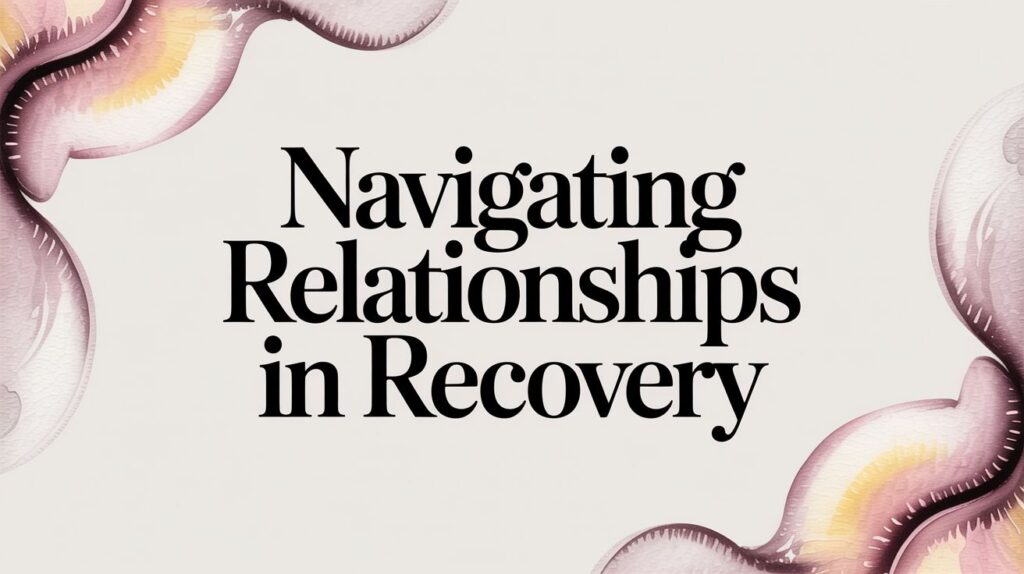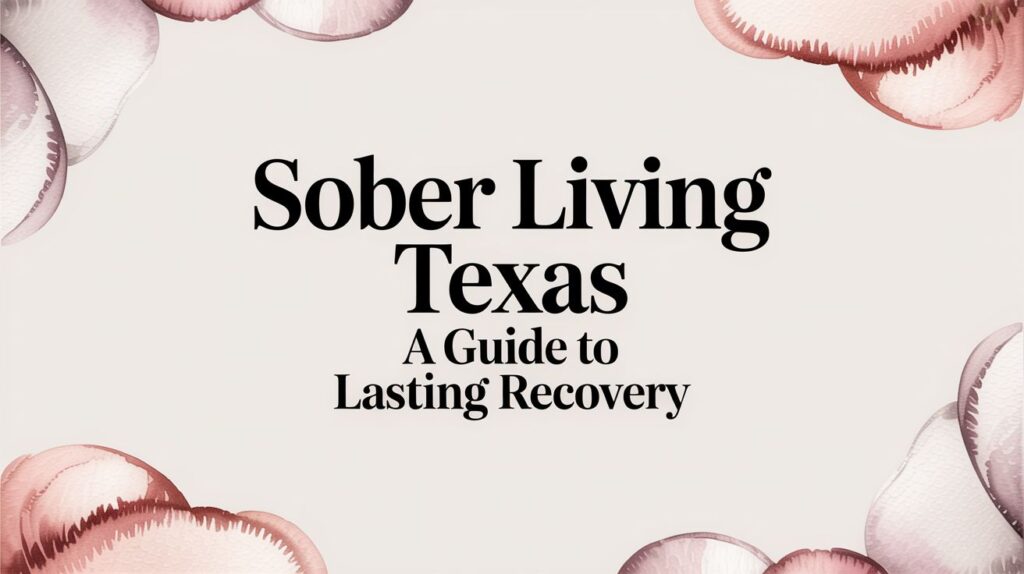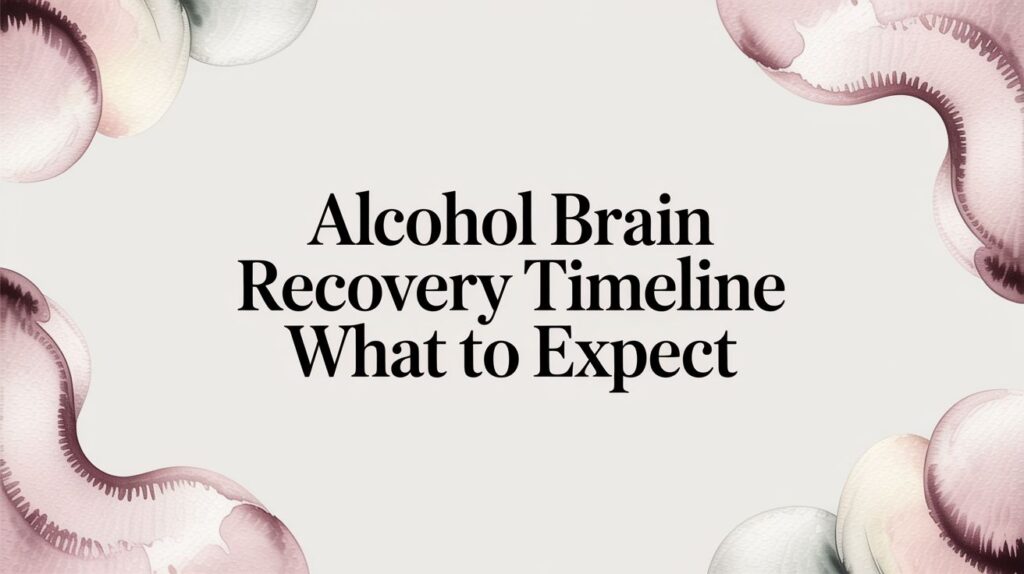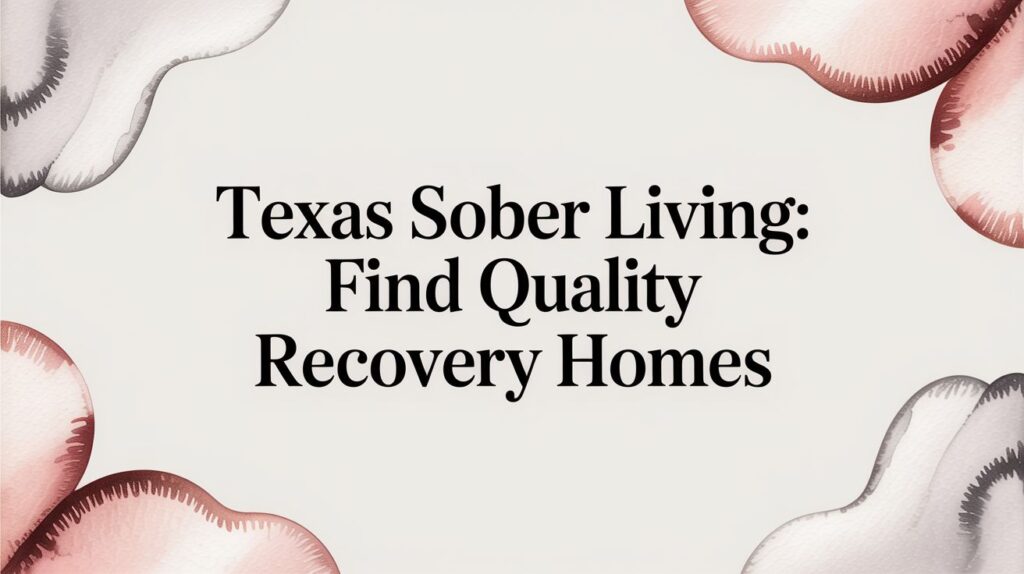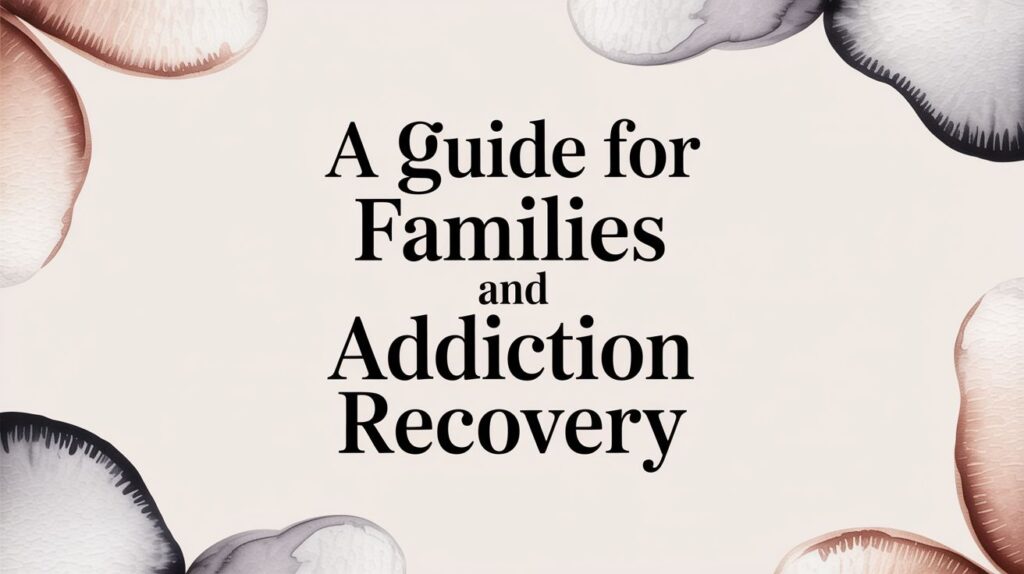Relationships in recovery aren't just about avoiding substances; they're about learning to reconnect. It’s a delicate process of rebuilding trust, drawing healthier lines, and finding new ways to talk to each other. The goal is to transform connections once damaged by addiction into powerful sources of mutual support, honesty, and lasting well-being for everyone involved.
The Impact of Addiction on Relationships
Substance use disorder never stays in a neat little box. It’s more like a storm that rips through a person’s life, rearranging everything—especially their most important connections. Family, partners, and friends are often the first to feel the tremors, left to carry the weight of broken promises, constant fear, and deep-seated resentment.
Over time, the very foundation of these relationships starts to crack. Communication that was once open and easy becomes guarded and defensive. Instead of talking about everyday life, conversations circle endlessly around the substance use—hiding it, confronting it, or cleaning up its messes. This state of constant crisis slowly erodes the emotional intimacy that once held everything together, leaving distance and misunderstanding in its wake.
Shifting Roles and Responsibilities
As addiction digs in, the roles people play in a family or partnership get twisted out of shape. A spouse shifts from a partner to a full-time caretaker. A parent, trying to help, becomes an enabler. A friend turns into a constant rescuer.
These changes are almost never intentional. They are survival tactics, adopted on the fly to cope with the chaos. The problem is, they create unhealthy patterns that can be just as hard to break as the addiction itself. For loved ones, trying to navigate this new landscape is incredibly isolating, which is why finding dedicated support groups for spouses of alcoholics and others in similar boats is so vital.
"Addiction rearranges the emotional furniture in a family. The goal of recovery is not just to stop the substance use, but to put everything back in a way that feels safe, supportive, and honest for everyone."
To get a clearer picture of these shifts, it helps to see them side-by-side.
How Addiction Changes Relationship Dynamics
| Relationship Aspect | Healthy Dynamic | Impacted by Addiction |
|---|---|---|
| Communication | Open, honest, and direct. | Guarded, dishonest, or focused on conflict. |
| Trust | Assumed and reciprocal. | Broken by lies, secrets, and unmet promises. |
| Roles | Balanced and mutually agreed upon. | Distorted into caretaker, enabler, or rescuer roles. |
| Boundaries | Clear, respected, and flexible. | Blurred, inconsistent, or frequently violated. |
| Emotional Intimacy | Safe, vulnerable, and supportive. | Replaced by fear, resentment, and emotional distance. |
These patterns don't just happen overnight; they build up gradually, leaving everyone feeling stuck. Recognizing them is the first step toward untangling the mess.
Why Healing Relationships is Essential for Recovery
Tackling these relational wounds isn’t just a "nice-to-have" part of recovery; it’s absolutely fundamental to building a strong, lasting sobriety. Healthy, supportive connections provide the accountability, encouragement, and motivation a person needs to get through the toughest challenges.
Research backs this up completely, showing that stable, intimate relationships significantly improve recovery outcomes. One major study found that individuals who were married or living with a partner reported greater recovery strengths and fewer barriers compared to those who were single or separated.
For this healing to even begin, it’s critical for everyone involved to see addiction as an illness, not a character flaw. This shift in perspective fosters the empathy needed to move forward without blame. It creates a compassionate foundation, allowing the whole family system to mend.
By focusing on repairing these bonds, you aren’t just helping one person get better—you are healing the entire relational ecosystem, making it strong enough to support a future free from substance use.
A Practical Guide to Rebuilding Trust
When the chaos of active addiction finally quiets down, the relational landscape is often a mess. Trust, the very bedrock of any close bond, is usually the biggest casualty, shattered by broken promises and betrayal. Piecing it back together isn't about a single grand apology. It’s a slow, deliberate process of laying a new foundation, one small, honest brick at a time.
This journey is a marathon, not a sprint, and it has to start with radical accountability.
There’s simply no room for excuses or justifications for past behavior. Real accountability means owning the pain you caused without tacking on a “but…” at the end. It's the difference between "I'm sorry for what I did" and "I'm sorry, but I was really struggling." The first opens the door to healing; the second props it open for resentment to creep back in.
This first step is all about acknowledging the full scope of the damage. It means you have to listen without getting defensive, validate their hurt, and accept that their skepticism is a direct result of your past actions. This isn't a one-and-done conversation—it's an ongoing posture of humility.
The infographic below shows how relationships often move through the strain of addiction and into the active work of healing.
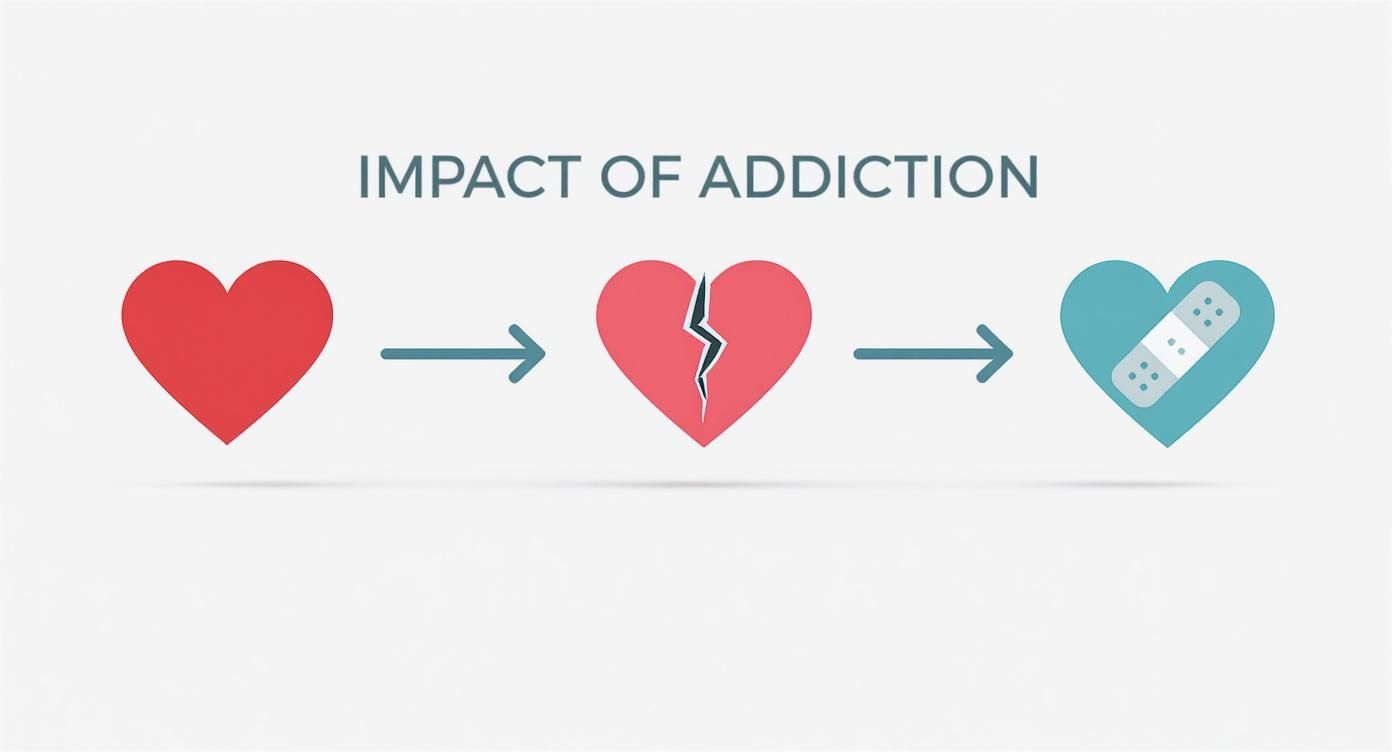
As the visual makes clear, the journey from a healthy connection to one damaged by substance use—and finally toward a mended, healing state—requires a distinct and active repair process.
Consistency: The Currency of Trust
Words can only do so much to patch up what's been broken. The real heavy lifting of rebuilding trust happens through action. Day in and day out, consistency is the currency of trust. It's earned through thousands of small, reliable behaviors that prove your commitment to change over the long haul.
Think of trust like a bank account that’s been completely drained. Every time your actions line up with your words, you make a tiny deposit. Show up when you say you will. Call when you promise. Be totally transparent about your recovery efforts. These aren't minor details; they are the deposits that slowly, painstakingly build the balance back up.
Trust is rebuilt in the smallest of moments. It's not the grand gestures that mend a broken bond, but the quiet consistency of a thousand right choices.
On the flip side, any inconsistency—a missed call, a vague answer, a broken promise—acts as a massive withdrawal, often wiping out the goodwill from many previous deposits. This is why patience is so vital for everyone involved in relationships in recovery. You have to be patient with the process, and your loved one needs patience with their own healing. For anyone trying to navigate this, exploring effective strategies for rebuilding trust after betrayal can provide a helpful roadmap.
Actionable Steps to Earn Back Trust
To move from idea to reality, you need to take concrete steps. Here are three core areas to focus on that will demonstrate a genuine commitment to rebuilding what was lost.
-
Practice Total Transparency: Secrecy is the enemy of trust. Your life needs to become an open book, especially when it comes to your recovery. Share who you’re talking to in your support network, what you’re learning in therapy, and be honest about both your struggles and your wins. This level of openness eliminates the doubt and suspicion that thrived during active use.
-
Follow Through on All Commitments: Make your word your bond, starting with the little things. If you say you’ll be home at 6 PM, be there at 6 PM. If you're running late, communicate that ahead of time. Proving your reliability in these small matters builds the confidence needed for them to trust you with the big ones.
-
Accept and Respect Boundaries: Your loved ones will likely put up new boundaries to protect their own well-being. Maybe they need to check in more often or ask that you not carry large amounts of cash. Instead of seeing these rules as a lack of faith, view them as necessary guardrails that help the relationship heal. Respecting them without an argument is a powerful way to show you get it and are committed to making them feel safe again.
Breaking Free from Codependent Patterns
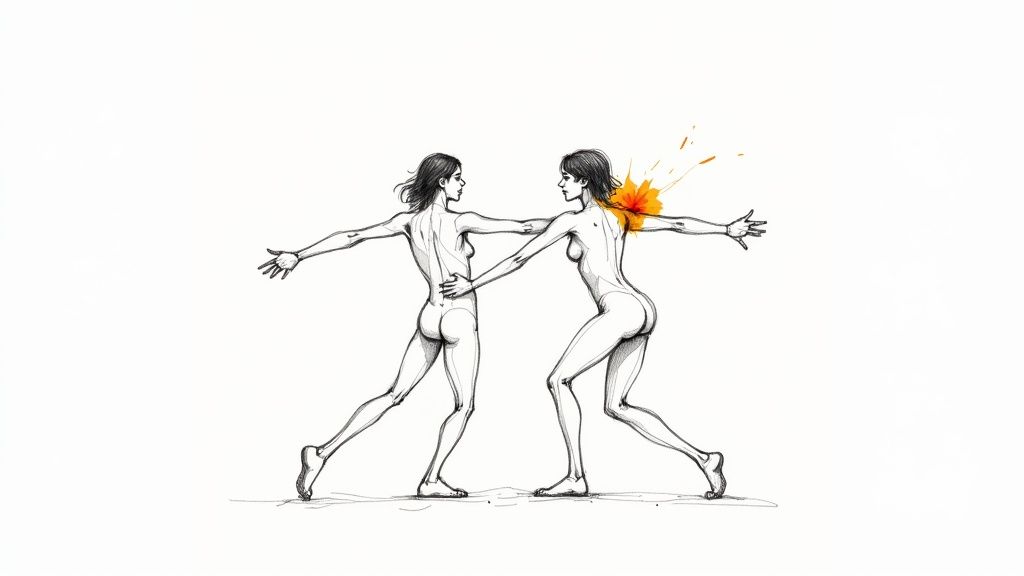
In the thick of a loved one's addiction, codependency isn't a character flaw—it’s a survival strategy that’s stopped working. It starts as a frantic attempt to manage the chaos, but it quickly becomes an exhausting cycle where one person's substance use dictates everyone else's emotions and actions.
The non-using partner often ends up trying to fix, control, or clean up the fallout, sacrificing their own needs along the way. While this can feel like an act of deep love or loyalty, it’s a different beast entirely. Genuine support empowers someone to walk their own recovery path. Codependency, on the other hand, accidentally enables the addiction by creating a buffer against the real-world consequences of their choices.
Learning to spot that difference is a game-changer for everyone in relationships in recovery. It means realizing your worth isn't tied to your ability to "save" someone. It’s about stepping back so that both of you can learn to stand on your own two feet.
Distinguishing Support from Enabling
Figuring out the fine line between helping and enabling is one of the toughest hurdles for families and partners. Stepping back can feel like abandonment, but what you’re really doing is creating the space for your loved one to finally take ownership of their own healing.
Think of it this way: If someone is drowning, support is throwing them a life raft and coaching them toward the shore. Enabling is jumping into the water to hold their head up while you slowly go under yourself. You might keep them afloat for a bit, but neither of you is getting any closer to safety.
Here’s how this plays out in real life:
- Financial Situations: Calling their boss with an excuse or paying their overdue rent is enabling. Offering to help them build a budget or driving them to a job interview is support.
- Emotional Crises: Lying to family members to cover up their behavior or taking the blame for their outbursts enables the cycle. Listening with empathy and encouraging them to talk it over with their therapist is support.
- Daily Responsibilities: Cleaning up their messes or handling all the household chores so they don’t have to is enabling. Encouraging them to take on their fair share and holding them accountable is support.
When you stop enabling, you aren't being cruel. You are restoring the natural sense of accountability that is absolutely essential for long-term sobriety.
Common Signs of Codependent Behavior
Codependency is sneaky; it often masquerades as simple care and concern. The first step toward healthier relationship dynamics is learning to spot these patterns in your own behavior. You might be caught in a codependent cycle if you find yourself constantly:
- Sacrificing Your Needs: Your own health, hobbies, and friendships always seem to land on the back burner while you manage the other person's life.
- Feeling Responsible for Their Actions: You carry a heavy burden of guilt, believing that if you had just done something differently, you could have prevented their substance use.
- Deriving Self-Esteem from Being Needed: Your sense of value and purpose is wrapped up in being a caretaker or rescuer.
- Having Poor Boundaries: You have a hard time saying "no" and frequently agree to things that make you uncomfortable just to avoid a fight or disapproval.
Codependency is the illusion of control. The reality is that by trying to manage someone else's life, you lose control of your own. True healing begins when you reclaim your autonomy.
Recognizing these signs isn't a reason for shame—it's a starting point for change. It often means seeking out your own support. Exploring different group topics for addiction recovery in a therapy setting can offer immense clarity and a sense of community. It gives you a safe place to unpack these complex dynamics, ensuring that as your loved one heals, you do, too.
Mastering Communication and Healthy Boundaries
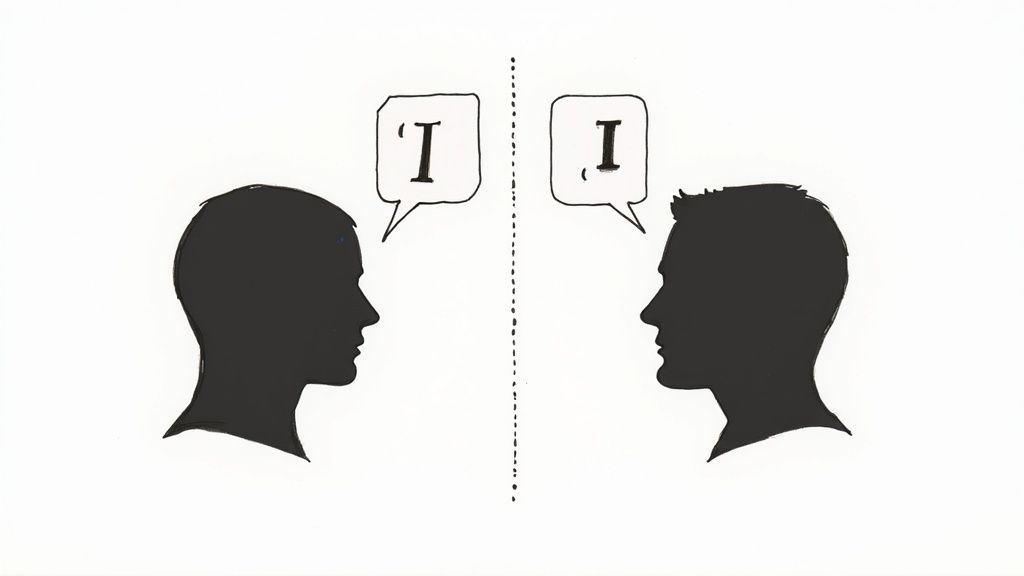
If rebuilding trust is the goal, then solid communication and healthy boundaries are the tools you’ll use to get there. During active substance use, conversations often turn into minefields of blame, defensiveness, and painful misunderstandings. Recovery is your chance to learn a new language—one built on honesty, respect, and emotional safety.
This shift doesn't happen overnight. It takes conscious effort to replace old, destructive habits with new, constructive ones. Instead of pointing fingers, you learn to express your own feelings and needs clearly. This creates a space where both people can finally feel heard without immediately feeling attacked.
The Power of "I" Statements
One of the simplest yet most effective tools for turning a difficult conversation around is the "I" statement. This small tweak in phrasing shifts the focus from blaming the other person to explaining your own emotional experience. It’s the difference between saying, "You never listen to me," and "I feel unheard when I'm talking."
The first statement is an accusation, practically guaranteeing a fight. The second is an invitation for the other person to understand your perspective.
Here’s a simple formula for building an "I" statement:
- Start with your feeling: "I feel…" (e.g., hurt, anxious, overwhelmed).
- Describe the specific behavior: "…when you…" (e.g., raise your voice, don't answer my texts).
- Explain the impact on you: "…because…" (e.g., it makes me feel like my opinion doesn't matter).
Using this structure turns accusations into opportunities for connection and is a cornerstone for healing relationships in recovery. This isn't about being soft; it's about being clear, direct, and far more effective.
Understanding Boundaries as Rules of Engagement
Boundaries aren’t walls you build to keep people out. Think of them as the clear rules of engagement that protect your well-being and, most importantly, your sobriety. They’re like the guardrails on a bridge—they don't block the path forward; they just keep everyone safe as they cross from one side to the other.
In the past, boundaries were likely blurred or nonexistent. Recovery is the time to redraw them with intention. This means getting crystal clear on what you will and will not accept in terms of behavior, communication, and even financial support. Research consistently shows how valuable this structured approach is. Treatments that include family or partners in the process can lead to a 5.7% annual reduction in substance use frequency, a powerful motivator for everyone to get on the same page. You can discover more insights about family involvement in recovery and its proven benefits.
Boundaries are a form of self-respect. They teach others how you expect to be treated and, more importantly, they reinforce your commitment to your own health and recovery.
Setting boundaries can feel incredibly uncomfortable at first, especially if your relationships have a history of codependency. It requires you to say "no" without guilt and to hold your ground even when faced with pressure or emotional pushback.
Practical Scripts for Setting Healthy Boundaries
When you're in a tough spot, having a few pre-planned, respectful scripts can make all the difference. The goal isn’t to be cold, but to be firm, kind, and direct. Below are some common scenarios showing the shift from an old, unhealthy response to a new, boundary-setting one.
Practical Scripts for Setting Healthy Boundaries
| Scenario | Unhealthy Response (Old Pattern) | Healthy Boundary Script (New Pattern) |
|---|---|---|
| A loved one asks for money. | Giving them money out of guilt or fear, even if you suspect it will be used for substances. | "I love you and I want to support you, but I can't give you money. I am happy to help you find a meeting or drive you to therapy." |
| A family member is being emotionally manipulative. | Giving in to their demands to avoid a conflict or make them happy. | "I can hear that you're upset, but I'm not going to change my mind. This boundary is important for my recovery and our relationship." |
| A partner brings up past mistakes in an argument. | Getting defensive, yelling, or shutting down completely. | "I'm not willing to have this conversation when it's focused on blame. If you'd like to talk about how we can move forward, I'm ready to listen." |
Remember, these scripts aren't about winning an argument. They are about protecting your peace and reinforcing the new, healthy foundation you are building for all your relationships.
How to Create a Shared Relapse Prevention Plan
While the ultimate goal is always lasting sobriety, recovery isn't a straight line. Setbacks can happen. But a relapse doesn't have to be a catastrophe; with a solid plan, it becomes a manageable challenge that can actually reinforce everyone's commitment to healing.
Creating a shared relapse prevention plan is a game-changer. It transforms loved ones from anxious spectators into a proactive, supportive team. This collaborative approach takes the guesswork and fear out of those high-stakes moments. Instead of reacting with panic or anger, everyone has a clear, agreed-upon script to follow, strengthening relationships in recovery through a sense of shared purpose.
Identifying Triggers Together
The first step is simple but powerful: sit down together when things are calm and openly map out the risks. This isn't about blame. It's about gathering intelligence to protect the progress that's been so hard-won. The person in recovery should take the lead, honestly sharing the triggers they already know about.
Loved ones can add huge value here by gently mentioning patterns they've seen from the outside. For this conversation to work, the space has to feel completely safe and free of judgment. Open, honest communication is everything.
Common triggers usually fall into a few key areas:
- Emotional States: Intense stress, anxiety, sadness, or even extreme joy can spark an urge to use.
- Social Situations: Certain friends, specific places, or annual events tied to past substance use are often high-risk zones.
- Environmental Cues: Something as simple as seeing a particular object, hearing a song on the radio, or smelling a certain scent can trigger a powerful craving.
It's also critical to identify the early warning signs of alcohol addiction or other substance use. These subtle shifts in behavior are often the first signals of a potential slip, giving the support system a chance to step in before a full relapse takes hold.
Building a Clear Action Plan
Once the triggers are on the table, the next step is to build a specific, actionable plan for what to do when they show up. This plan should spell out what the person in recovery will do and how their loved ones can provide effective support—which is very different from control.
Let's say work stress is a major trigger. A solid action plan might look like this:
- Immediate Action: The person in recovery commits to calling their sponsor or therapist right after a particularly tough day at the office.
- Partner's Role: The partner agrees to help create a calm, low-pressure home environment on those evenings. Maybe they suggest a walk or putting on a movie instead of immediately asking about work.
- Backup Plan: If the urge to use is still strong despite these steps, they have a pre-arranged agreement to go to a support group meeting together that same night.
A relapse prevention plan is like a fire drill for recovery. You practice it when things are calm so that if there’s ever a real emergency, everyone knows exactly what to do to keep each other safe.
Agreeing on a Relapse Protocol
This is the toughest part of the conversation, but it's also the most important. You have to agree, ahead of time, on what happens if a relapse does occur. This protocol isn't about punishment; it's about immediate safety and getting reconnected to recovery tools as quickly as possible.
The plan needs to outline clear, non-negotiable steps. It could be an agreement that if substance use is suspected, a loved one will drive the individual straight to a meeting or call their therapist. It might also involve pre-agreed boundaries, like not allowing the person to stay in the family home while under the influence to protect children or maintain a safe environment for everyone.
Having this protocol locked in place beforehand eliminates the need for heated, emotional decisions in the middle of a crisis. It ensures that the response is guided by love, safety, and a shared goal: getting back on the path to recovery without delay.
Knowing When to Seek Professional Support
While communication and a genuine desire to heal can move mountains, some relationship challenges are more like bedrock. You can push and pull with all your might, but certain dynamics just won't budge. If you’ve given it your all and still feel stuck, it’s probably time to bring in a neutral, trained professional to help clear the path.
Recognizing this isn't a sign of failure—it's an act of courage. It means you’re committed to building a future on solid ground, even if it means asking for help laying the foundation. Professional support provides the tools and structured environment needed to untangle knots that feel too tight to undo on your own.
Signs It Is Time for Professional Help
Sometimes, unhealthy patterns of conflict or dysfunction can become so ingrained they start to feel normal. It’s crucial to step back and honestly assess if your relationship is showing signs that it needs professional intervention. Constant conflict, arguments that go in circles without ever getting resolved, or a complete communication shutdown are all major red flags.
You should seriously consider seeking outside help if you notice:
- Persistent Resentment: One or both of you can't seem to move past old hurts, and that bitterness now colors most of your interactions.
- Deep-Rooted Codependency: Even though you know the patterns are unhealthy, you feel powerless to break free from enabling or controlling behaviors.
- Mental Health Concerns: When recovery is complicated by co-occurring conditions like anxiety or depression, specialized guidance is essential. Our guide on integrated dual diagnosis treatment explains how these intertwined issues can be addressed together.
Types of Professional Support Available
Fortunately, you are not alone on this journey. In the United States, over 29 million adults report having resolved a significant substance use problem, highlighting the massive community of people who have walked this path before you. The support network is robust, with options designed to fit different needs. To get a better sense of the scope of recovery across the country, you can explore these addiction and recovery statistics.
Seeking therapy for your relationship is like bringing in an architect to look at your blueprints. A professional can spot structural weaknesses you're too close to see and provide the expertise to ensure what you're building together will last.
Key professional resources include:
- Family Therapy: This brings multiple family members into the room to focus on healing the entire relational system, not just one person.
- Couples Counseling: A therapist works with both partners to improve communication, rebuild intimacy, and navigate the specific challenges that recovery brings to a partnership.
- Support Groups: Programs like Al-Anon or Co-Dependents Anonymous (CoDA) offer invaluable peer support and practical coping strategies for loved ones affected by addiction.
Answering the Tough Questions About Relationships in Recovery
When you're navigating recovery, your relationships can feel like uncharted territory. It’s completely normal to have questions and feel a bit lost. Let's tackle some of the most common concerns head-on with practical answers to help you and your loved ones find your footing.
These situations are almost always complex. The right path forward is the one that protects everyone’s long-term safety and well-being.
How Long Does It Take to Rebuild Trust?
Honestly, there’s no magic timeline. Think of trust as something you build brick by brick, not a switch you can just flip back on. It’s a gradual process. For the person in recovery, consistency is everything. Your actions have to line up with your words, day in and day out. Every kept promise is like a small deposit into an account that’s been overdrawn for a long time.
For family and friends, this requires a deep well of patience. It means learning to acknowledge real progress while still protecting your own emotional health. The focus has to be on the pattern of positive behavior over time, not a specific deadline. Real trust is earned, not demanded.
Can a Relationship Survive a Relapse?
Yes, a relationship can absolutely survive a relapse, but it demands a serious recommitment from everyone involved. A relapse is a major setback, no question, but it doesn't have to be the final chapter. The real key is how everyone responds to it.
This is exactly why having a relapse prevention plan discussed ahead of time is so crucial. The immediate goals are to ensure safety, get back in touch with support systems (like therapists and sponsors), and talk openly about what triggered the event. When a relapse is treated as a learning opportunity to strengthen the recovery plan, it can end up reinforcing a couple's shared commitment instead of tearing them apart.
A relapse doesn't erase all the progress that's been made; it shines a light on where the recovery plan needs to be stronger. How you respond to the setback is often more important than the setback itself.
Is It Okay to End a Relationship with Someone in Recovery?
Yes. It is always okay to put your own safety and mental health first. While you can be an incredible source of support for someone's recovery, you are not—and cannot be—responsible for it. Their sobriety is ultimately their journey.
If a relationship has become toxic, abusive, or is just consistently chipping away at your well-being despite all your efforts, choosing to leave can be the healthiest and bravest decision you can make. Support groups like Al-Anon are designed specifically to help people navigate these incredibly tough choices with clarity and strength.
How Do I Support a Loved One Without Enabling Them?
This is the tightrope walk so many families face. The distinction is critical: support empowers their recovery, while enabling shields them from the natural consequences of their choices.
- Support looks like: Encouraging them to go to therapy, celebrating recovery milestones, listening without judgment, and holding firm to your boundaries. It’s about cheering on their positive actions.
- Enabling looks like: Making excuses for their behavior, giving them money you suspect will be misused, lying for them, or taking on responsibilities that are theirs to manage. It cushions the impact of their negative choices.
The goal is to foster their independence, not their dependence on you.
Navigating the complexities of relationships in recovery is a journey you don't have to take alone. At Altura Recovery, our family systems therapy and outpatient programs provide the expert guidance and support needed to heal connections and build a strong foundation for the future. Contact us today to learn how we can help your family heal together.

